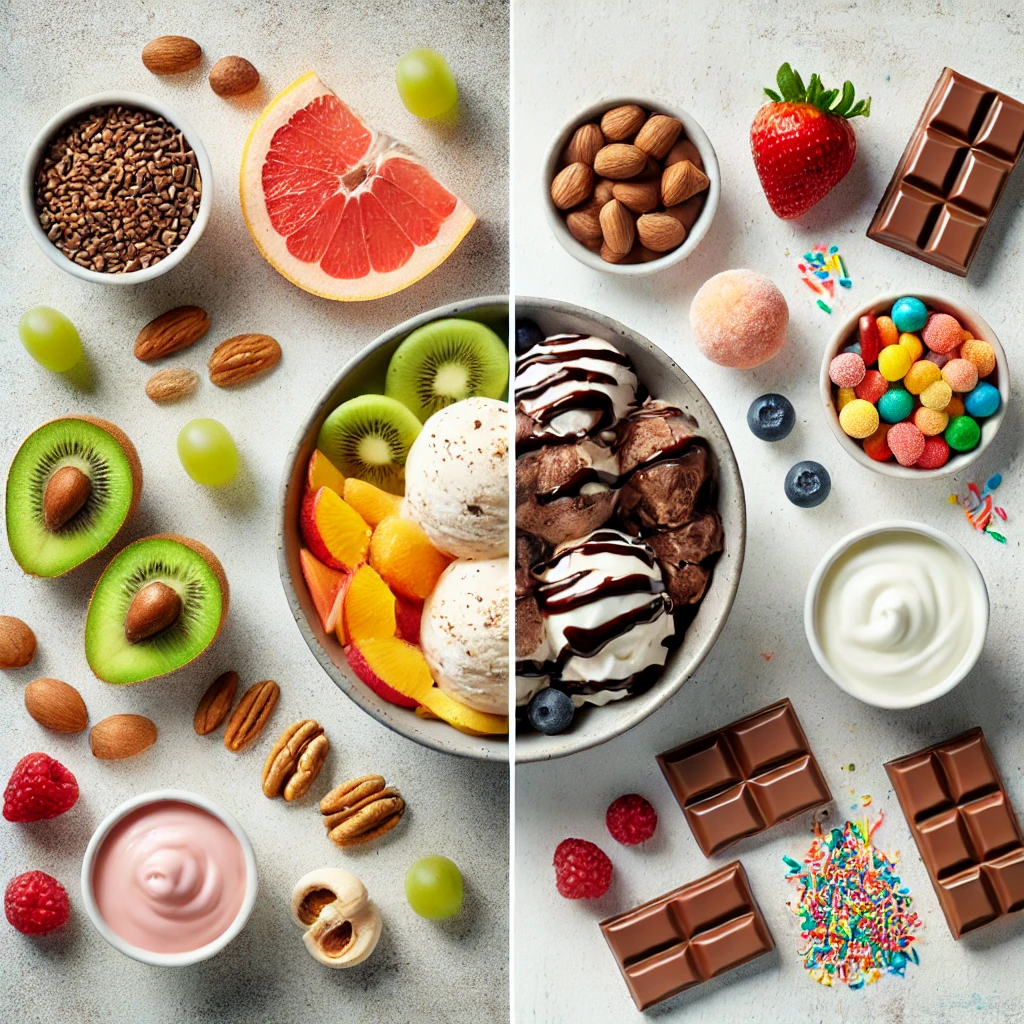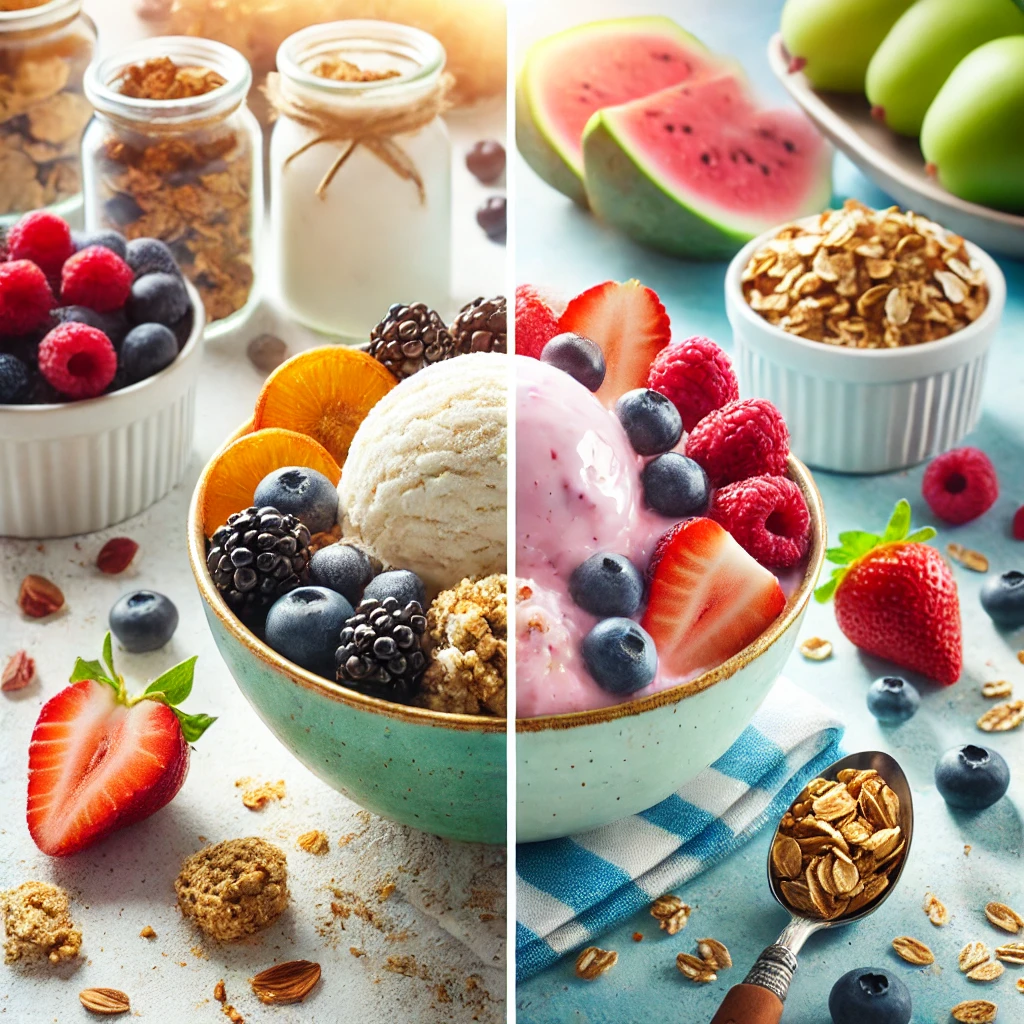
Craving something cold, creamy, and delicious but wondering which treat is the better choice for your health?
We’ve all been there, standing in front of the freezer section, debating whether to go for a scoop of gelato or ice cream.
While both are undeniably tasty, when it comes to health, there are some clear differences between the two.
Let’s dive into this ultimate showdown—Gelato vs Ice Cream: Which Frozen Treat is Healthier?
What is Gelato?

Gelato is a traditional Italian frozen dessert that has been enjoyed for centuries, known for its rich, creamy texture and intense flavors.
Although it is often compared to ice cream, gelato stands out due to its unique preparation process and ingredients, making it a distinct and beloved treat worldwide.
How Gelato is Made
The process of making gelato differs from that of ice cream in several key ways.
One of the primary differences is that gelato is made with more milk and less cream, which results in a lower fat content.
Typically, gelato contains around 4% to 9% fat, while ice cream can have anywhere from 10% to 16%.
This reduced fat content allows the flavors in gelato to shine more prominently, as fat in ice cream tends to coat the tongue, muting the intensity of the flavors.
Additionally, gelato is churned at a much slower rate than ice cream.
This slow churning process incorporates less air into the mixture, which creates a denser and smoother texture.
In contrast, ice cream is churned at a faster speed, resulting in a lighter and fluffier consistency.
The slow churning of gelato not only enhances its creamy mouthfeel but also leads to a more concentrated flavor.
Ingredients in Gelato

Gelato is made from a few simple, high-quality ingredients.
The base typically consists of milk, sugar, and natural flavorings like fruit, nuts, chocolate, or even coffee.
In traditional Italian gelato, the use of natural ingredients is a hallmark, meaning artificial flavorings and preservatives are often avoided.
This emphasis on freshness and natural flavors makes gelato feel more artisanal and often healthier, depending on the ingredients used.
- Milk: The primary liquid in gelato, contributing to its creamy but less fatty texture compared to ice cream.
- Sugar: Adds sweetness and helps achieve the smooth consistency gelato is known for.
- Flavorings: These can range from fresh fruits like strawberries, lemon, or mango, to indulgent flavors like pistachio, hazelnut, and chocolate.
- Egg Yolks: Some varieties of gelato, particularly richer ones like chocolate or custard-based flavors, may include egg yolks to enhance creaminess and provide a silkier texture.
The Texture and Flavor of Gelato
One of the standout features of gelato is its texture, which is softer and more elastic than ice cream.
It is often served at a slightly warmer temperature, around 10 to 15 degrees Fahrenheit, which helps bring out its rich, full-bodied flavor.
Ice cream, by comparison, is served at much colder temperatures, which can sometimes dull the intensity of its taste.
The slow churn process and lower fat content of gelato allow the natural flavors to come through more vibrantly.
Whether it’s a tart fruit flavor or a deep, nutty pistachio, the ingredients are usually more pronounced in gelato, making each bite an explosion of flavor.
This is why gelato often feels more satisfying even in smaller servings.
Gelato Around the World
Though it originated in Italy, gelato has spread globally and can be found in artisanal gelato shops worldwide.
However, authentic Italian gelato is often distinguished by its use of fresh, local ingredients and adherence to traditional preparation methods.
When you visit an Italian gelato shop, you’re likely to notice that the gelato is stored in metal tins rather than the large tubs common in ice cream shops, another indicator of its artisanal quality.
Why Gelato May Be a Healthier Option
Because gelato contains less fat than ice cream, it can be a slightly healthier option for those watching their fat intake.
Additionally, its intense flavors may allow you to feel satisfied with smaller portions, making it easier to enjoy in moderation.
The emphasis on natural, high-quality ingredients also contributes to its reputation as a more wholesome treat compared to some mass-produced ice creams that contain artificial additives.
In summary, gelato is more than just Italian ice cream—it’s a dessert that prioritizes high-quality ingredients, a dense and smooth texture, and rich, intense flavors.
Whether you’re enjoying a classic fruit gelato or indulging in a chocolate-hazelnut variety, gelato offers a delicious and often healthier alternative to ice cream.
What is Ice Cream?

Ice cream is a beloved frozen dessert enjoyed by people of all ages around the world.
Known for its rich, creamy texture and variety of flavors, ice cream is a staple treat for cooling off on a hot day or indulging in a sweet craving.
Although it shares similarities with other frozen desserts like gelato and sorbet, ice cream stands out due to its distinct ingredients, higher fat content, and the way it’s made.
How Ice Cream is Made
The process of making ice cream is an intricate blend of science and art.
At its core, ice cream is made from a mixture of cream, milk, sugar, and flavorings.
These ingredients are combined and churned at high speeds while being frozen, incorporating air into the mixture to give ice cream its light and fluffy texture.
The rapid churning process also prevents large ice crystals from forming, which is crucial to achieving the smooth, creamy consistency that ice cream is known for.
Ice cream contains more cream than gelato, which contributes to its higher fat content.
Typically, ice cream has a fat content ranging from 10% to 16%, depending on the recipe and brand.
This higher fat content not only gives ice cream a rich mouthfeel but also helps stabilize the dessert, keeping it smooth and scoopable even after freezing.
Ingredients in Ice Cream

While the basic ingredients of ice cream are simple, variations in recipes allow for a wide range of flavors and textures.
Here’s a breakdown of the essential ingredients used in ice cream:
- Cream and Milk: The primary ingredients in ice cream, cream and milk provide the fat that gives ice cream its rich texture. Higher cream content results in a creamier, more indulgent dessert.
- Sugar: Sugar is responsible for the sweetness of ice cream and also helps lower the freezing point, making the ice cream softer and easier to scoop.
- Egg Yolks: In some ice cream recipes, particularly those for premium or custard-based varieties, egg yolks are added to enhance the creaminess and provide a velvety texture.
- Flavorings: Ice cream can be flavored with virtually anything—classic flavors like vanilla and chocolate to more adventurous ones like cookie dough, salted caramel, or mint chocolate chip. Natural and artificial flavorings are both used, depending on the recipe and brand.
- Stabilizers and Emulsifiers: Many commercial ice creams include stabilizers like guar gum or carrageenan to help maintain a smooth texture by preventing ice crystals from forming. Emulsifiers, such as lecithin, are also used to keep the fat and water from separating.
Texture and Flavor of Ice Cream
One of the defining features of ice cream is its texture—light, airy, and creamy.
The higher cream content, combined with the fast-churning process, results in a fluffy consistency, thanks to the incorporation of air into the mixture.
This added air is what distinguishes ice cream from denser frozen desserts like gelato.
The amount of air churned into the ice cream, known as “overrun,” can vary, with premium ice creams having less air and a denser texture compared to more commercial varieties.
Ice cream is also served at colder temperatures than gelato, which makes it harder to scoop but gives it a firmer structure.
The colder serving temperature can slightly mute the flavors of ice cream compared to the more pronounced flavors in gelato, which is served at a warmer temperature.
In terms of flavor, ice cream has a wide range of options.
Whether you prefer simple vanilla or more complex flavors like rocky road or cookies and cream, there’s an ice cream flavor for every taste.
Many ice creams also include mix-ins like chocolate chips, nuts, cookie pieces, or fruit, adding texture and variety to the dessert.
Types of Ice Cream

Over the years, different types of ice cream have evolved to cater to various preferences and dietary needs.
- Traditional Ice Cream: This is the standard ice cream made from cream, milk, sugar, and flavorings. It’s available in countless flavors and textures, from soft serve to hand-scooped varieties.
- Custard-Based Ice Cream: Also known as French-style ice cream, this type includes egg yolks in the base, resulting in a richer, creamier texture. It’s thicker and more indulgent than traditional ice cream.
- Soft Serve: Soft serve ice cream has a lower fat content and is churned more quickly, resulting in a lighter, softer texture. It’s usually served at a slightly warmer temperature than hard ice cream, making it smoother and easier to eat.
- Low-Fat or Light Ice Cream: For those watching their calorie intake, low-fat or light ice creams offer a healthier alternative. These versions use less cream and often substitute some of the sugar with artificial or natural sweeteners.
- Non-Dairy Ice Cream: With the rise of plant-based diets, non-dairy ice creams made from almond milk, coconut milk, soy milk, or oat milk have become popular. These options cater to vegans or those with lactose intolerance.
- Frozen Yogurt: While not technically ice cream, frozen yogurt offers a tangy, lighter alternative. It’s made with yogurt instead of cream, resulting in a lower fat content but a more tart flavor.
Nutritional Value of Ice Cream
Ice cream is often considered an indulgence due to its high fat and sugar content.
A standard serving of ice cream (about ½ cup) typically contains:
- Calories: 200–250 calories
- Fat: 10–16 grams of fat
- Sugar: 20–30 grams of sugar
Premium ice creams tend to have higher fat and calorie counts due to the increased use of cream and egg yolks.
On the other hand, light or low-fat versions can have significantly fewer calories and fat, but may contain artificial sweeteners or stabilizers to maintain texture and flavor.
Despite its reputation as a guilty pleasure, ice cream can be enjoyed in moderation as part of a balanced diet.
Many brands now offer low-calorie options or alternatives made with natural sweeteners and reduced-fat milk, allowing you to indulge without overloading on calories.
Why Ice Cream is So Popular

Ice cream’s popularity can be attributed to its versatility, rich flavors, and the emotional comfort it brings.
Whether it’s enjoyed in a cone, bowl, sundae, or milkshake, ice cream can be tailored to suit personal preferences, making it one of the most customizable desserts.
Moreover, ice cream often evokes feelings of nostalgia and happiness, making it a go-to treat for celebrations, hot summer days, or simply as a comforting snack.
Is Ice Cream a Healthy Choice?
While ice cream is certainly delicious, it’s important to consume it in moderation due to its high fat and sugar content.
If you’re looking for a healthier option, consider choosing light or low-fat varieties, or even making homemade ice cream with natural ingredients.
There are also plenty of non-dairy and plant-based options that offer the same creamy texture.
In summary, ice cream is a rich and creamy frozen treat loved by many, thanks to its indulgent texture and endless variety of flavors.
Made with cream, milk, sugar, and flavorings, ice cream’s high fat content gives it its signature smoothness and richness, making it a satisfying dessert when enjoyed in moderation.
Whether you’re enjoying a classic vanilla scoop or experimenting with more exotic flavors, ice cream is a versatile dessert that can be tailored to suit any taste or dietary preference.
Nutritional Comparison
Calories and Fat Content
| Frozen Treat | Calories (per ½ cup serving) | Fat (grams) |
|---|---|---|
| Gelato | 140-170 | 4-9 |
| Ice Cream | 200-250 | 10-16 |
While the calorie difference between the two isn’t huge, gelato typically contains less fat due to its lower cream content.
For those watching their fat intake, gelato is a better option.
Sugar Content
Gelato often contains slightly less sugar than ice cream, though this can vary depending on the brand or recipe.
If you’re concerned about sugar, look for low-sugar versions of both treats.
You can also make healthier versions at home using natural sweeteners like agave or honey, which you can easily find in most health-conscious products.
Dairy and Lactose Considerations
Both gelato and ice cream contain dairy, which can be an issue for those who are lactose intolerant.
However, many lactose-free alternatives are available for both, allowing you to enjoy these treats without discomfort.
Opting for a dairy-free gelato or ice cream made from almond or coconut milk can be a great solution.
Protein and Additives
While neither gelato nor ice cream is a significant source of protein, it’s worth mentioning that some ice creams contain added stabilizers and preservatives to maintain their texture.
If you’re looking for a healthier option, choose varieties made with natural ingredients and fewer additives.
Organic and natural brands are good alternatives for those who want to avoid synthetic ingredients.
Health Benefits and Drawbacks

Health Benefits of Gelato
- Lower fat content: With less cream and fewer calories, gelato can be a more waistline-friendly option.
- Rich flavor: Because it’s churned more slowly, gelato’s flavor is more concentrated, allowing you to enjoy smaller portions without feeling deprived.
- More natural ingredients: Many gelato brands use fewer preservatives and additives compared to commercial ice cream.
Health Benefits of Ice Cream
- Satisfying richness: The higher fat content in ice cream can make it more filling and satisfying, which means you might be able to enjoy a smaller serving and still feel content.
- Variety of flavors: Ice cream comes in an endless variety of flavors, giving you more options to choose from, including healthier, low-fat versions.
Drawbacks of Both
- High sugar content: Both gelato and ice cream can contain high amounts of sugar, which can contribute to weight gain and other health issues if consumed in large quantities.
- Dairy: For those with lactose intolerance or dairy sensitivities, both options can cause digestive discomfort.
Which Option is Healthier?
So, when it comes down to Gelato vs Ice Cream: Which Frozen Treat is Healthier?, the answer depends on your personal health goals.
- If you’re watching your calorie and fat intake, gelato might be the better choice due to its lower fat content and smaller serving size.
- If you’re looking for a more indulgent, filling dessert, ice cream may be your go-to, especially if you opt for a smaller portion of a high-quality brand.
In terms of overall health benefits, gelato edges out ice cream slightly due to its natural ingredients and lower fat content.
However, portion control is key for both, and you can enjoy either option as part of a balanced diet.
How to Make Healthier Choices

Here are a few tips to enjoy these frozen treats without overindulging:
1. Choose Smaller Portions
Both gelato and ice cream are easy to overeat, especially when served in large bowls or cones. Try using smaller cups or dishes to keep your portions in check.
2. Opt for Low-Sugar Varieties
Many brands offer reduced-sugar or no-sugar-added versions of both gelato and ice cream.
Look for options that use natural sweeteners like monk fruit or stevia to satisfy your sweet tooth without the extra sugar.
3. Homemade Alternatives
Making gelato or ice cream at home allows you to control the ingredients and adjust for dietary preferences.
For a healthier twist, try using almond or coconut milk, and sweeten with natural alternatives like honey or maple syrup.
Recommended Products for a Homemade Treat
You can easily make your own healthier version of gelato or ice cream at home with the right tools.
Consider using a compact ice cream maker that allows you to churn small batches with minimal effort.
For sweeteners, opt for organic honey or agave syrup to keep the sugar content lower while still achieving a creamy, flavorful result.
Conclusion
In the end, both gelato and ice cream have their place in a healthy diet when enjoyed in moderation.
If you’re looking for a lighter option with fewer calories and fat, gelato is a great choice.
However, if you’re in the mood for something more indulgent, ice cream can hit the spot.
Just remember, balance and portion control are key!
Which one is your favorite frozen treat?
Gelato or ice cream?
Let us know in the comments below, and don’t forget to check out our recommended products to create your own healthy versions at home!
Related Articles:
10 Irresistible Ice Cream Sandwich Recipes You Have to Try This Summer!



